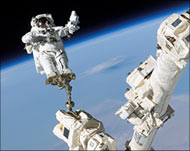Discovery landing shifted to California
The Space Shuttle Discovery has been cleared to land on Tuesday at California’s Edwards Air Force Base after weather thwarted its planned landing in Florida, Nasa officials have said.

Nasa twice rejected landing opportunities on Monday and did the same with the first chance to land the shuttle on Tuesday at the Kennedy Space Centre on Florida’s east coast.
Nasa prefers landing the shuttle in Florida rather than California. A landing at Edwards involves a week of processing time, a $1 million expense and the risk of a cross-country ferry flight to return the shuttle to Florida.
“At this time we’re going to ask you guys to watch the Earth go by for one more rev (orbit),” astronaut Ken Ham radioed from Mission Control to the shuttle.
“We understand how unstable weather is in Florida so we’re not surprised at all,” shuttle commander Eileen Collins replied.
Nasa has several chances to land the shuttle on Tuesday, including a second opportunity at 6.43am EDT (1043 GMT) in Florida and at 8.12am EDT and 9.47am EDT at Edwards Air Force Base in California, the primary backup site.
Discovery also could land at the secondary backup site, the White Sands Test Facility in New Mexico, at 6.39am EDT (1039 GMT) or 8.13am EDT (1213 GMT).
Visibility important
Barring emergencies, Nasa will only land Discovery if there is at least 8km of visibility for the approach to the runway and no rain, lightning or thunderstorms within 56km.
 |
|
Astronaut Stephen Robinson |
The landing will bring to a close Nasa’s first shuttle mission since Discovery’s sister ship Columbia was destroyed on 1 February 2003, 16 minutes from landing.
Columbia’s wing was critically damaged during launch by a piece of insulating foam that fell from the shuttle fuel tank.
As the spacecraft raced through Earth’s atmosphere 16 days later for landing, superheated gases blasted into the hole, ripping the ship apart and killing all seven astronauts on board.
Nasa spent $1 billion on repairs and safety upgrades. But a chunk of insulating foam almost as large as the one that damaged Columbia flew off Discovery’s fuel tank at launch on 26 July, showing Nasa managers they had failed to fix the problem.
The space agency grounded the shuttle fleet again and said they would not fly until the foam problem was solved.
Discovery spent nine days at the International Space Station on a servicing and resupply mission. The crew delivered a new steering gyroscope to the outpost and revived a second failed device.
Repairs
The astronauts also made the shuttle programme’s first in-flight heat shield repair.
Astronaut Stephen Robinson rode the space station’s robot arm to Discovery’s belly to remove two protruding cloth strips from the smooth surface of the ship’s belly.
Nasa managers were concerned the strips could disrupt air flow over the shuttle and raise temperatures beyond what the shuttle can withstand.